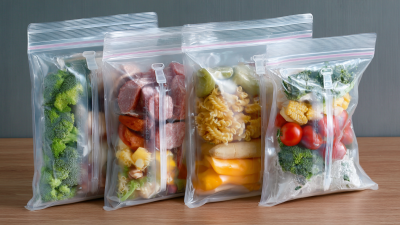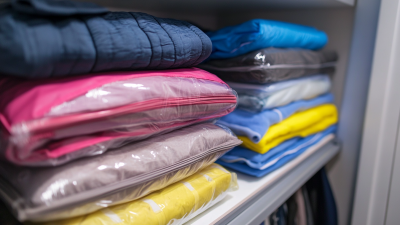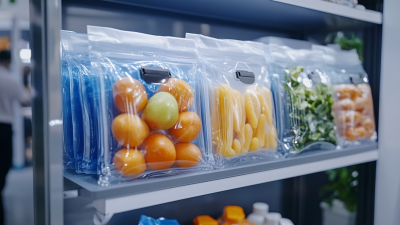As home organization becomes a pressing priority for many, the importance of maximizing closet space cannot be overstated. According to a recent report by the National Association of Professional Organizers, 82% of Americans feel overwhelmed by the clutter in their homes, particularly within their closets. With the shifting seasons demanding the rotation of clothing, Clothes Vacuum Bags have emerged as a revolutionary solution for efficient storage.

When it comes to seasonal storage, choosing the right vacuum bags for different clothing types can significantly maximize closet space. According to industry reports, using vacuum storage bags can save up to 75% of space, making them a popular choice for homeowners looking to declutter. Different fabrics, such as cotton, wool, and synthetic fibers, require specific types of vacuum bags to maintain their integrity and prevent damage. For instance, breathable bags are ideal for wool garments to prevent moisture buildup, while airtight bags are perfect for preserving delicate fabrics.
In addition to fabric considerations, size and configuration also play critical roles in selecting vacuum bags. Standard bags can accommodate most garments, but larger bags are necessary for bulkier items like winter jackets and blankets. With the rise of smart home technology, many brands have introduced features to enhance the user experience, such as clear windows for easy identification and double-zip seals for efficient air removal. Data from consumer surveys indicate that 80% of people prefer vacuum bags with these features for their ease of use and effectiveness in keeping clothes fresh.
When it comes to preparing clothes for seasonal storage, proper cleaning and folding techniques are crucial to keep your garments in pristine condition. Start by giving your clothes a thorough wash. Remove any stains, dirt, or odors that could set in over time. Use a fabric-appropriate detergent and follow the care instructions on the labels. For delicate items, consider dry cleaning to ensure they retain their quality. Once cleaned, allow the clothing to air dry completely to prevent mold and mildew from forming during storage.
Folding clothes correctly is just as important as cleaning them. To maximize space and minimize wrinkles, try using the flat folding method. Lay the garment flat, fold the sleeves inward, and then fold the sides towards the center. For bulkier items like sweaters, consider rolling to save space and prevent creasing. Place items into vacuum bags, ensuring they are not overstuffed, to maintain air circulation and fit everything securely. With the right preparation, your seasonal clothing will be ready for storage and will emerge fresh and ready to wear when the new season arrives.
When it comes to maximizing closet space, using vacuum bags is one of the most efficient packing techniques. These bags not only compress clothing, allowing for more items to fit into a limited space, but they also protect your garments from dust, moisture, and pests. By efficiently utilizing vacuum bags for seasonal storage, you can keep your closet organized and clutter-free, making it easier to find what you need when you need it.
To get the best results from vacuum bags, consider a few packing strategies. Fold clothes neatly to avoid wrinkles, and group similar items together—this not only makes packing easier but also helps maintain organization within the bags. It's advisable to fill the bags without overstuffing, as this ensures that they will seal properly and provide maximum compression. This method allows you to create more space in your closet or suitcase, whether you're preparing for a change of season or packing for travel. Employing these smart packing techniques can drastically reduce the amount of space your clothing occupies, giving your closet a neat and tidy appearance.
| Dimension | Vacuum Bag Type | Capacity (Cubic Feet) | Material | Best Use | Compression Ratio |
|---|---|---|---|---|---|
| Medium | Flat Vacuum Bags | 2.5 | Polyethylene | Storing Seasonal Clothing | 60% Reduction |
| Large | Space Saver Bags | 4.0 | Nylon | Blankets and Bedding | 70% Reduction |
| Extra Large | Roll-Up Vacuum Bags | 6.0 | PVC | Winter Coats | 80% Reduction |
| Small | Compression Bags | 1.5 | Multi-layer | Shoes and Accessories | 50% Reduction |
To ensure that your clothes vacuum bags provide optimal protection for your seasonal storage, proper sealing is essential. Begin by selecting high-quality vacuum bags designed specifically for clothing. Before adding your items, ensure that they are clean and completely dry to prevent mildew and odors. When packing your clothes, avoid overstuffing the bags, as this can compromise the vacuum seal. Lay items flat and remove as much air as possible using a vacuum. For added security, check the seal to confirm that it is tight and leak-proof.
Once sealed, store your vacuum bags in a cool, dry environment to maintain their integrity over time. Avoid exposure to direct sunlight, as this can weaken the material and affect the contents. Ideally, place the bags in a designated storage bin or closet where temperature fluctuations are minimal. Regularly check the condition of the bags and their contents, especially if stored for extended periods. By following these proper sealing and storing methods, you can maximize your closet space while ensuring that your seasonal clothes remain protected and in excellent condition for the next use.
To maintain freshness and avoid damage when using clothes vacuum bags for seasonal storage, it's essential to follow some best practices. First and foremost, ensure that the clothes are clean and completely dry before placing them in the bags. Any residual moisture or stains can lead to mildew and unwanted odors, ultimately damaging your garments. Additionally, consider using a gentle detergent during laundering to prevent any harsh chemicals from lingering on the fabric when sealed.
Once your clothes are clean, careful folding is vital. Avoid overstuffing the bags, as this can create pressure points that lead to creasing or permanent damage. Instead, fold garments neatly and layer them within the bag to maximize space while minimizing risk. After sealing the bag, store it in a cool, dry place, away from direct sunlight, which can fade colors and weaken fibers over time. Regularly check the bags for any signs of damage or moisture to ensure the longevity and freshness of your seasonal wardrobe.






